Case Study Analysis: Improving Internal Communication at Data Solution
VerifiedAdded on 2023/06/08
|6
|2351
|112
Case Study
AI Summary
This case study examines the internal communication challenges faced by Data Solution, a software management company. The memorandum highlights issues such as ineffective decision-making processes, communication gaps between supervisors and staff, and unprofessional email communications. The study analyzes these problems quantitatively and qualitatively, proposing solutions such as scheduled business meetings to improve decision dissemination, updated feedback processes to bridge the supervisor-staff communication gap, and training on professional email etiquette. The document also emphasizes the benefits of compliance for both employees and the organization, including risk management and increased efficiency. Contact details are provided for assistance, and a monthly update is suggested to track the progress of implemented actions. The case study concludes by outlining the significance of effective internal communication, the advantages of compliance, and the importance of providing assistance to employees and customers.
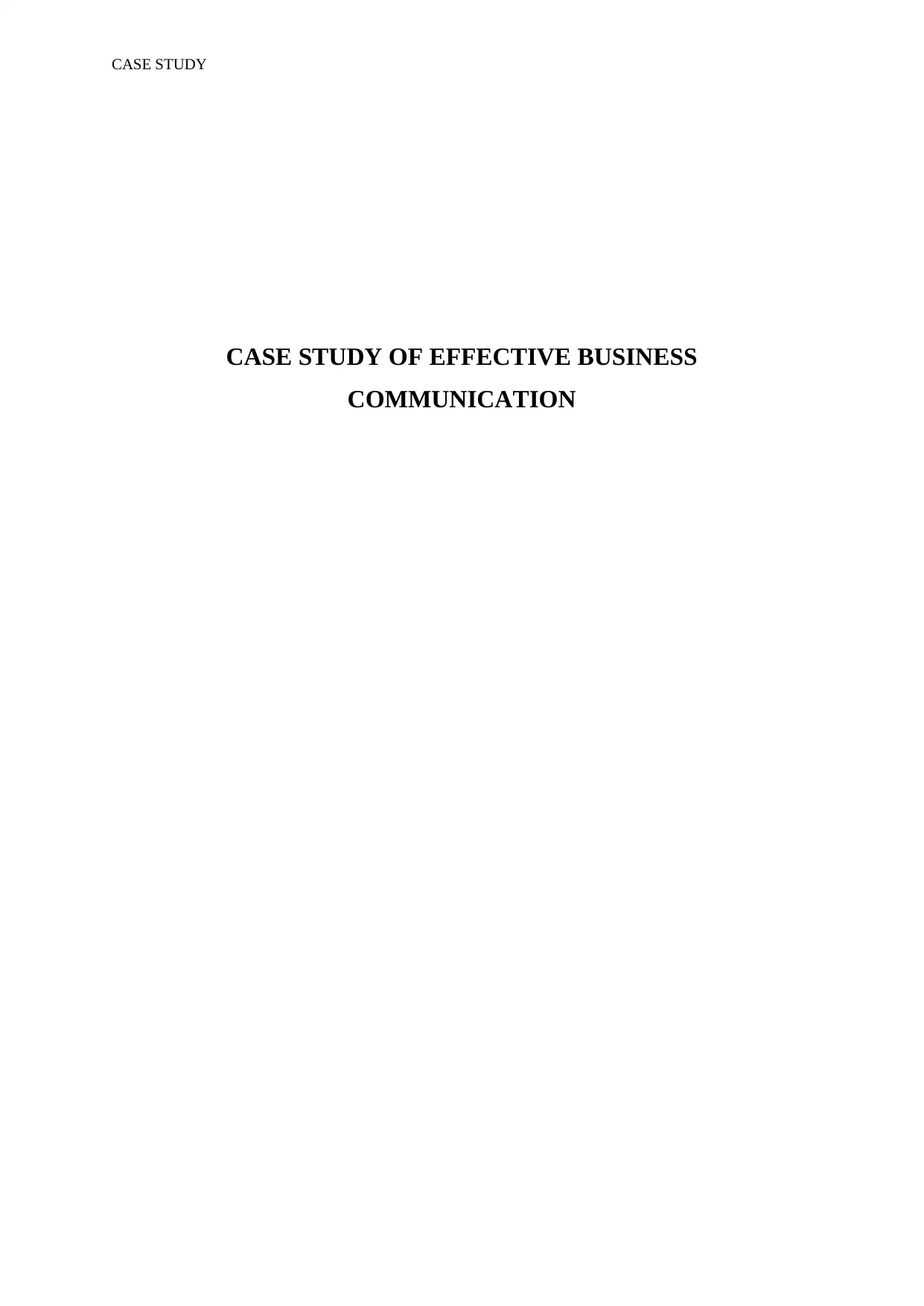
CASE STUDY
CASE STUDY OF EFFECTIVE BUSINESS
COMMUNICATION
CASE STUDY OF EFFECTIVE BUSINESS
COMMUNICATION
Paraphrase This Document
Need a fresh take? Get an instant paraphrase of this document with our AI Paraphraser
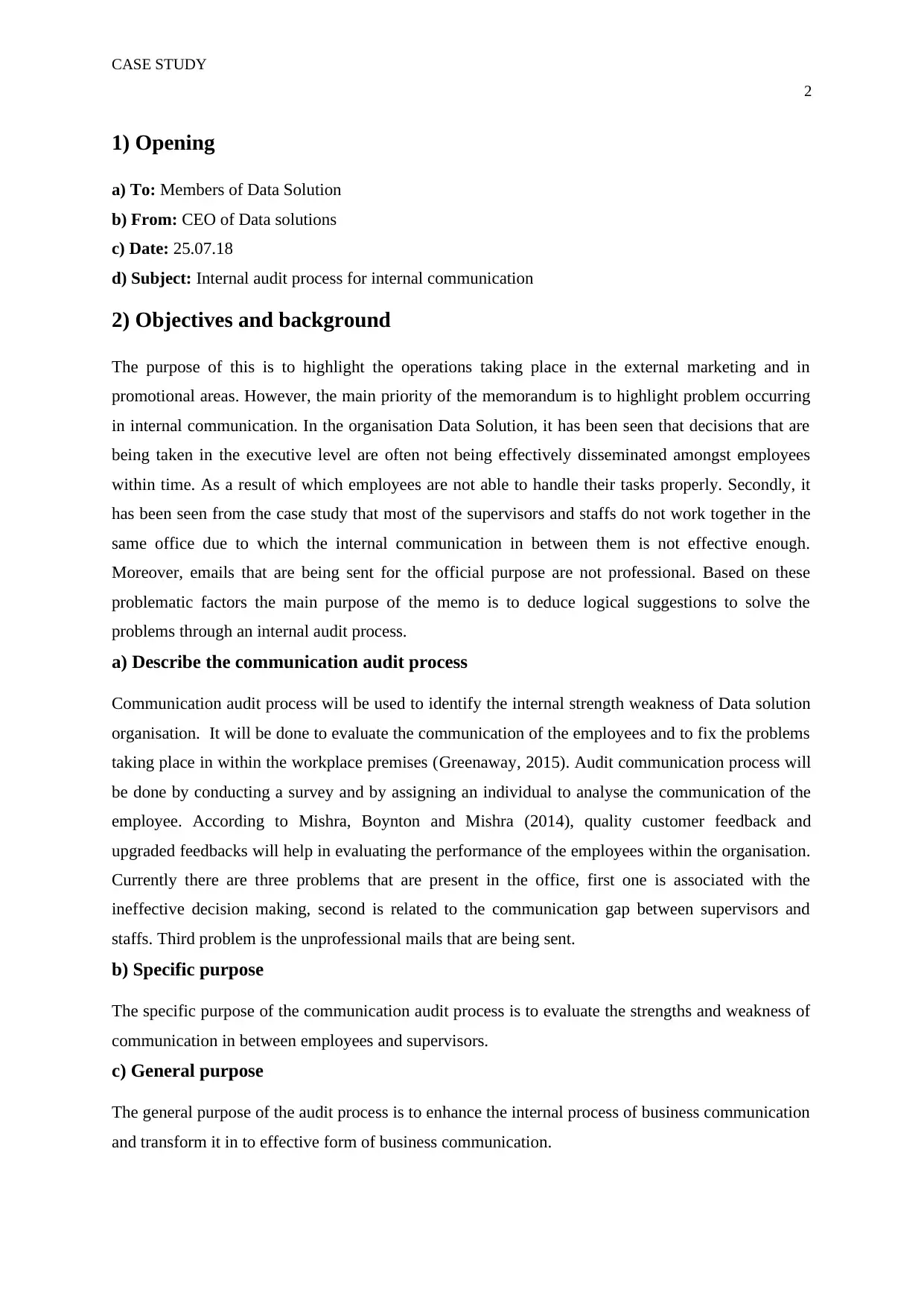
CASE STUDY
2
1) Opening
a) To: Members of Data Solution
b) From: CEO of Data solutions
c) Date: 25.07.18
d) Subject: Internal audit process for internal communication
2) Objectives and background
The purpose of this is to highlight the operations taking place in the external marketing and in
promotional areas. However, the main priority of the memorandum is to highlight problem occurring
in internal communication. In the organisation Data Solution, it has been seen that decisions that are
being taken in the executive level are often not being effectively disseminated amongst employees
within time. As a result of which employees are not able to handle their tasks properly. Secondly, it
has been seen from the case study that most of the supervisors and staffs do not work together in the
same office due to which the internal communication in between them is not effective enough.
Moreover, emails that are being sent for the official purpose are not professional. Based on these
problematic factors the main purpose of the memo is to deduce logical suggestions to solve the
problems through an internal audit process.
a) Describe the communication audit process
Communication audit process will be used to identify the internal strength weakness of Data solution
organisation. It will be done to evaluate the communication of the employees and to fix the problems
taking place in within the workplace premises (Greenaway, 2015). Audit communication process will
be done by conducting a survey and by assigning an individual to analyse the communication of the
employee. According to Mishra, Boynton and Mishra (2014), quality customer feedback and
upgraded feedbacks will help in evaluating the performance of the employees within the organisation.
Currently there are three problems that are present in the office, first one is associated with the
ineffective decision making, second is related to the communication gap between supervisors and
staffs. Third problem is the unprofessional mails that are being sent.
b) Specific purpose
The specific purpose of the communication audit process is to evaluate the strengths and weakness of
communication in between employees and supervisors.
c) General purpose
The general purpose of the audit process is to enhance the internal process of business communication
and transform it in to effective form of business communication.
2
1) Opening
a) To: Members of Data Solution
b) From: CEO of Data solutions
c) Date: 25.07.18
d) Subject: Internal audit process for internal communication
2) Objectives and background
The purpose of this is to highlight the operations taking place in the external marketing and in
promotional areas. However, the main priority of the memorandum is to highlight problem occurring
in internal communication. In the organisation Data Solution, it has been seen that decisions that are
being taken in the executive level are often not being effectively disseminated amongst employees
within time. As a result of which employees are not able to handle their tasks properly. Secondly, it
has been seen from the case study that most of the supervisors and staffs do not work together in the
same office due to which the internal communication in between them is not effective enough.
Moreover, emails that are being sent for the official purpose are not professional. Based on these
problematic factors the main purpose of the memo is to deduce logical suggestions to solve the
problems through an internal audit process.
a) Describe the communication audit process
Communication audit process will be used to identify the internal strength weakness of Data solution
organisation. It will be done to evaluate the communication of the employees and to fix the problems
taking place in within the workplace premises (Greenaway, 2015). Audit communication process will
be done by conducting a survey and by assigning an individual to analyse the communication of the
employee. According to Mishra, Boynton and Mishra (2014), quality customer feedback and
upgraded feedbacks will help in evaluating the performance of the employees within the organisation.
Currently there are three problems that are present in the office, first one is associated with the
ineffective decision making, second is related to the communication gap between supervisors and
staffs. Third problem is the unprofessional mails that are being sent.
b) Specific purpose
The specific purpose of the communication audit process is to evaluate the strengths and weakness of
communication in between employees and supervisors.
c) General purpose
The general purpose of the audit process is to enhance the internal process of business communication
and transform it in to effective form of business communication.
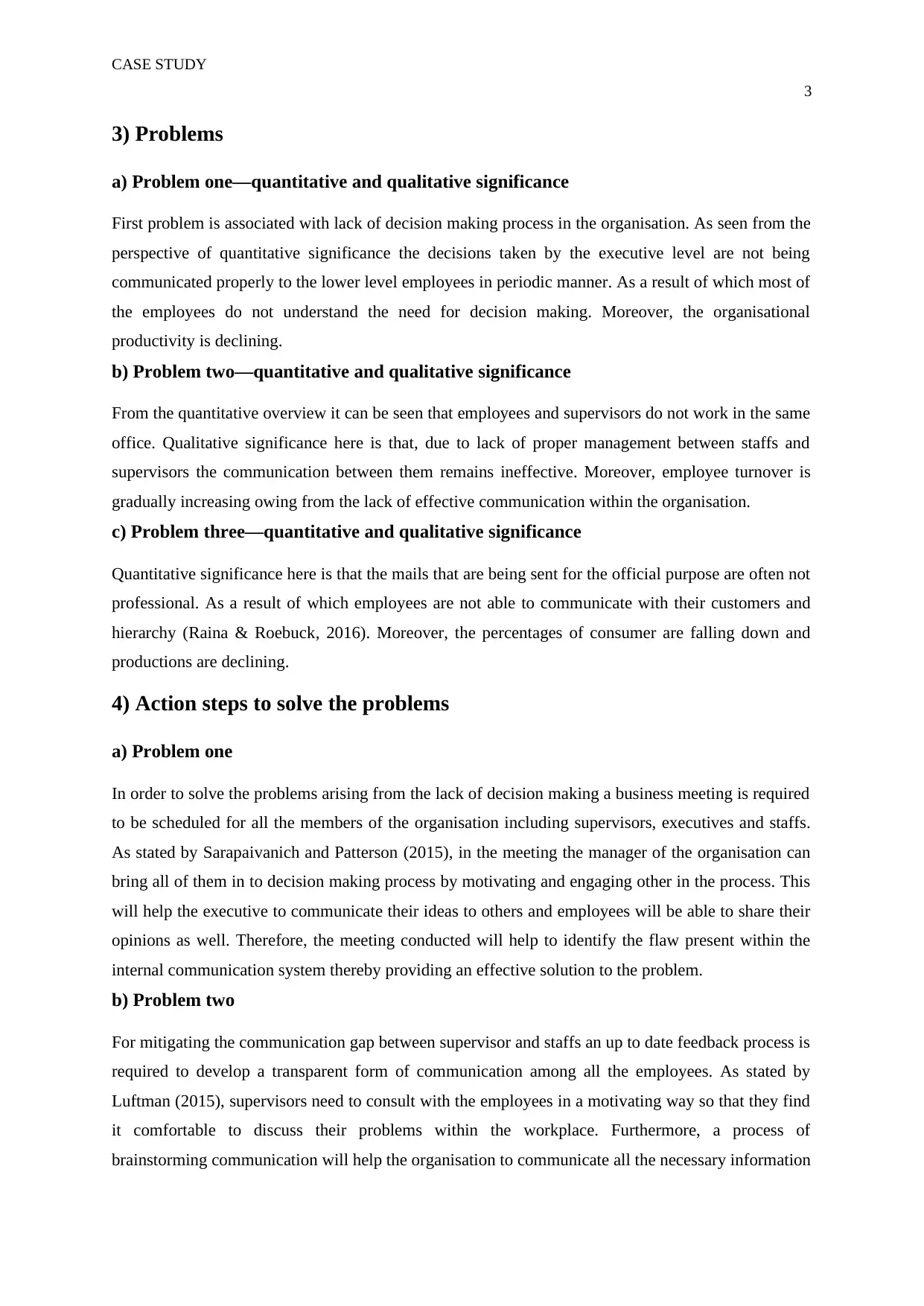
CASE STUDY
3
3) Problems
a) Problem one—quantitative and qualitative significance
First problem is associated with lack of decision making process in the organisation. As seen from the
perspective of quantitative significance the decisions taken by the executive level are not being
communicated properly to the lower level employees in periodic manner. As a result of which most of
the employees do not understand the need for decision making. Moreover, the organisational
productivity is declining.
b) Problem two—quantitative and qualitative significance
From the quantitative overview it can be seen that employees and supervisors do not work in the same
office. Qualitative significance here is that, due to lack of proper management between staffs and
supervisors the communication between them remains ineffective. Moreover, employee turnover is
gradually increasing owing from the lack of effective communication within the organisation.
c) Problem three—quantitative and qualitative significance
Quantitative significance here is that the mails that are being sent for the official purpose are often not
professional. As a result of which employees are not able to communicate with their customers and
hierarchy (Raina & Roebuck, 2016). Moreover, the percentages of consumer are falling down and
productions are declining.
4) Action steps to solve the problems
a) Problem one
In order to solve the problems arising from the lack of decision making a business meeting is required
to be scheduled for all the members of the organisation including supervisors, executives and staffs.
As stated by Sarapaivanich and Patterson (2015), in the meeting the manager of the organisation can
bring all of them in to decision making process by motivating and engaging other in the process. This
will help the executive to communicate their ideas to others and employees will be able to share their
opinions as well. Therefore, the meeting conducted will help to identify the flaw present within the
internal communication system thereby providing an effective solution to the problem.
b) Problem two
For mitigating the communication gap between supervisor and staffs an up to date feedback process is
required to develop a transparent form of communication among all the employees. As stated by
Luftman (2015), supervisors need to consult with the employees in a motivating way so that they find
it comfortable to discuss their problems within the workplace. Furthermore, a process of
brainstorming communication will help the organisation to communicate all the necessary information
3
3) Problems
a) Problem one—quantitative and qualitative significance
First problem is associated with lack of decision making process in the organisation. As seen from the
perspective of quantitative significance the decisions taken by the executive level are not being
communicated properly to the lower level employees in periodic manner. As a result of which most of
the employees do not understand the need for decision making. Moreover, the organisational
productivity is declining.
b) Problem two—quantitative and qualitative significance
From the quantitative overview it can be seen that employees and supervisors do not work in the same
office. Qualitative significance here is that, due to lack of proper management between staffs and
supervisors the communication between them remains ineffective. Moreover, employee turnover is
gradually increasing owing from the lack of effective communication within the organisation.
c) Problem three—quantitative and qualitative significance
Quantitative significance here is that the mails that are being sent for the official purpose are often not
professional. As a result of which employees are not able to communicate with their customers and
hierarchy (Raina & Roebuck, 2016). Moreover, the percentages of consumer are falling down and
productions are declining.
4) Action steps to solve the problems
a) Problem one
In order to solve the problems arising from the lack of decision making a business meeting is required
to be scheduled for all the members of the organisation including supervisors, executives and staffs.
As stated by Sarapaivanich and Patterson (2015), in the meeting the manager of the organisation can
bring all of them in to decision making process by motivating and engaging other in the process. This
will help the executive to communicate their ideas to others and employees will be able to share their
opinions as well. Therefore, the meeting conducted will help to identify the flaw present within the
internal communication system thereby providing an effective solution to the problem.
b) Problem two
For mitigating the communication gap between supervisor and staffs an up to date feedback process is
required to develop a transparent form of communication among all the employees. As stated by
Luftman (2015), supervisors need to consult with the employees in a motivating way so that they find
it comfortable to discuss their problems within the workplace. Furthermore, a process of
brainstorming communication will help the organisation to communicate all the necessary information
⊘ This is a preview!⊘
Do you want full access?
Subscribe today to unlock all pages.

Trusted by 1+ million students worldwide
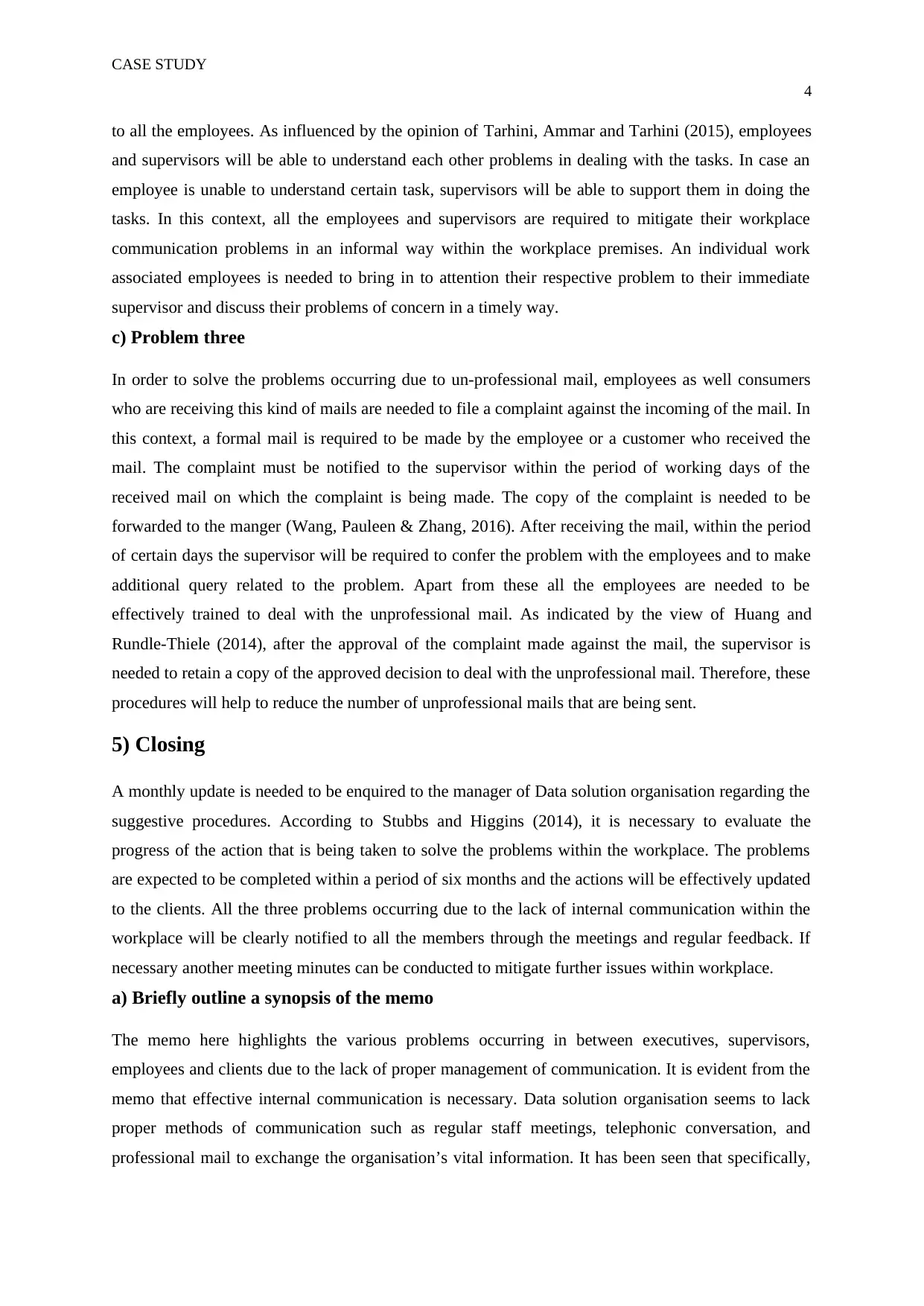
CASE STUDY
4
to all the employees. As influenced by the opinion of Tarhini, Ammar and Tarhini (2015), employees
and supervisors will be able to understand each other problems in dealing with the tasks. In case an
employee is unable to understand certain task, supervisors will be able to support them in doing the
tasks. In this context, all the employees and supervisors are required to mitigate their workplace
communication problems in an informal way within the workplace premises. An individual work
associated employees is needed to bring in to attention their respective problem to their immediate
supervisor and discuss their problems of concern in a timely way.
c) Problem three
In order to solve the problems occurring due to un-professional mail, employees as well consumers
who are receiving this kind of mails are needed to file a complaint against the incoming of the mail. In
this context, a formal mail is required to be made by the employee or a customer who received the
mail. The complaint must be notified to the supervisor within the period of working days of the
received mail on which the complaint is being made. The copy of the complaint is needed to be
forwarded to the manger (Wang, Pauleen & Zhang, 2016). After receiving the mail, within the period
of certain days the supervisor will be required to confer the problem with the employees and to make
additional query related to the problem. Apart from these all the employees are needed to be
effectively trained to deal with the unprofessional mail. As indicated by the view of Huang and
Rundle-Thiele (2014), after the approval of the complaint made against the mail, the supervisor is
needed to retain a copy of the approved decision to deal with the unprofessional mail. Therefore, these
procedures will help to reduce the number of unprofessional mails that are being sent.
5) Closing
A monthly update is needed to be enquired to the manager of Data solution organisation regarding the
suggestive procedures. According to Stubbs and Higgins (2014), it is necessary to evaluate the
progress of the action that is being taken to solve the problems within the workplace. The problems
are expected to be completed within a period of six months and the actions will be effectively updated
to the clients. All the three problems occurring due to the lack of internal communication within the
workplace will be clearly notified to all the members through the meetings and regular feedback. If
necessary another meeting minutes can be conducted to mitigate further issues within workplace.
a) Briefly outline a synopsis of the memo
The memo here highlights the various problems occurring in between executives, supervisors,
employees and clients due to the lack of proper management of communication. It is evident from the
memo that effective internal communication is necessary. Data solution organisation seems to lack
proper methods of communication such as regular staff meetings, telephonic conversation, and
professional mail to exchange the organisation’s vital information. It has been seen that specifically,
4
to all the employees. As influenced by the opinion of Tarhini, Ammar and Tarhini (2015), employees
and supervisors will be able to understand each other problems in dealing with the tasks. In case an
employee is unable to understand certain task, supervisors will be able to support them in doing the
tasks. In this context, all the employees and supervisors are required to mitigate their workplace
communication problems in an informal way within the workplace premises. An individual work
associated employees is needed to bring in to attention their respective problem to their immediate
supervisor and discuss their problems of concern in a timely way.
c) Problem three
In order to solve the problems occurring due to un-professional mail, employees as well consumers
who are receiving this kind of mails are needed to file a complaint against the incoming of the mail. In
this context, a formal mail is required to be made by the employee or a customer who received the
mail. The complaint must be notified to the supervisor within the period of working days of the
received mail on which the complaint is being made. The copy of the complaint is needed to be
forwarded to the manger (Wang, Pauleen & Zhang, 2016). After receiving the mail, within the period
of certain days the supervisor will be required to confer the problem with the employees and to make
additional query related to the problem. Apart from these all the employees are needed to be
effectively trained to deal with the unprofessional mail. As indicated by the view of Huang and
Rundle-Thiele (2014), after the approval of the complaint made against the mail, the supervisor is
needed to retain a copy of the approved decision to deal with the unprofessional mail. Therefore, these
procedures will help to reduce the number of unprofessional mails that are being sent.
5) Closing
A monthly update is needed to be enquired to the manager of Data solution organisation regarding the
suggestive procedures. According to Stubbs and Higgins (2014), it is necessary to evaluate the
progress of the action that is being taken to solve the problems within the workplace. The problems
are expected to be completed within a period of six months and the actions will be effectively updated
to the clients. All the three problems occurring due to the lack of internal communication within the
workplace will be clearly notified to all the members through the meetings and regular feedback. If
necessary another meeting minutes can be conducted to mitigate further issues within workplace.
a) Briefly outline a synopsis of the memo
The memo here highlights the various problems occurring in between executives, supervisors,
employees and clients due to the lack of proper management of communication. It is evident from the
memo that effective internal communication is necessary. Data solution organisation seems to lack
proper methods of communication such as regular staff meetings, telephonic conversation, and
professional mail to exchange the organisation’s vital information. It has been seen that specifically,
Paraphrase This Document
Need a fresh take? Get an instant paraphrase of this document with our AI Paraphraser
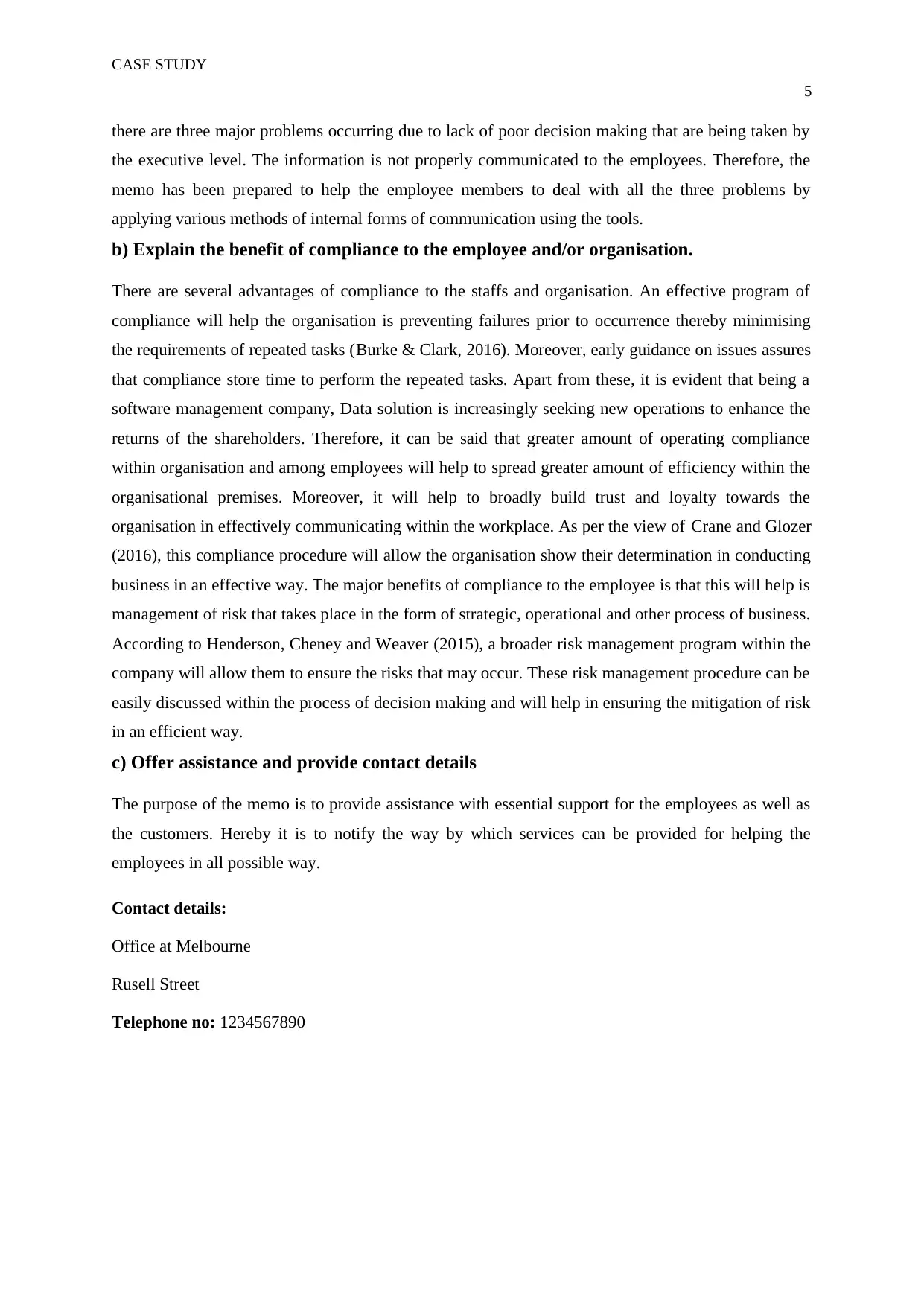
CASE STUDY
5
there are three major problems occurring due to lack of poor decision making that are being taken by
the executive level. The information is not properly communicated to the employees. Therefore, the
memo has been prepared to help the employee members to deal with all the three problems by
applying various methods of internal forms of communication using the tools.
b) Explain the benefit of compliance to the employee and/or organisation.
There are several advantages of compliance to the staffs and organisation. An effective program of
compliance will help the organisation is preventing failures prior to occurrence thereby minimising
the requirements of repeated tasks (Burke & Clark, 2016). Moreover, early guidance on issues assures
that compliance store time to perform the repeated tasks. Apart from these, it is evident that being a
software management company, Data solution is increasingly seeking new operations to enhance the
returns of the shareholders. Therefore, it can be said that greater amount of operating compliance
within organisation and among employees will help to spread greater amount of efficiency within the
organisational premises. Moreover, it will help to broadly build trust and loyalty towards the
organisation in effectively communicating within the workplace. As per the view of Crane and Glozer
(2016), this compliance procedure will allow the organisation show their determination in conducting
business in an effective way. The major benefits of compliance to the employee is that this will help is
management of risk that takes place in the form of strategic, operational and other process of business.
According to Henderson, Cheney and Weaver (2015), a broader risk management program within the
company will allow them to ensure the risks that may occur. These risk management procedure can be
easily discussed within the process of decision making and will help in ensuring the mitigation of risk
in an efficient way.
c) Offer assistance and provide contact details
The purpose of the memo is to provide assistance with essential support for the employees as well as
the customers. Hereby it is to notify the way by which services can be provided for helping the
employees in all possible way.
Contact details:
Office at Melbourne
Rusell Street
Telephone no: 1234567890
5
there are three major problems occurring due to lack of poor decision making that are being taken by
the executive level. The information is not properly communicated to the employees. Therefore, the
memo has been prepared to help the employee members to deal with all the three problems by
applying various methods of internal forms of communication using the tools.
b) Explain the benefit of compliance to the employee and/or organisation.
There are several advantages of compliance to the staffs and organisation. An effective program of
compliance will help the organisation is preventing failures prior to occurrence thereby minimising
the requirements of repeated tasks (Burke & Clark, 2016). Moreover, early guidance on issues assures
that compliance store time to perform the repeated tasks. Apart from these, it is evident that being a
software management company, Data solution is increasingly seeking new operations to enhance the
returns of the shareholders. Therefore, it can be said that greater amount of operating compliance
within organisation and among employees will help to spread greater amount of efficiency within the
organisational premises. Moreover, it will help to broadly build trust and loyalty towards the
organisation in effectively communicating within the workplace. As per the view of Crane and Glozer
(2016), this compliance procedure will allow the organisation show their determination in conducting
business in an effective way. The major benefits of compliance to the employee is that this will help is
management of risk that takes place in the form of strategic, operational and other process of business.
According to Henderson, Cheney and Weaver (2015), a broader risk management program within the
company will allow them to ensure the risks that may occur. These risk management procedure can be
easily discussed within the process of decision making and will help in ensuring the mitigation of risk
in an efficient way.
c) Offer assistance and provide contact details
The purpose of the memo is to provide assistance with essential support for the employees as well as
the customers. Hereby it is to notify the way by which services can be provided for helping the
employees in all possible way.
Contact details:
Office at Melbourne
Rusell Street
Telephone no: 1234567890
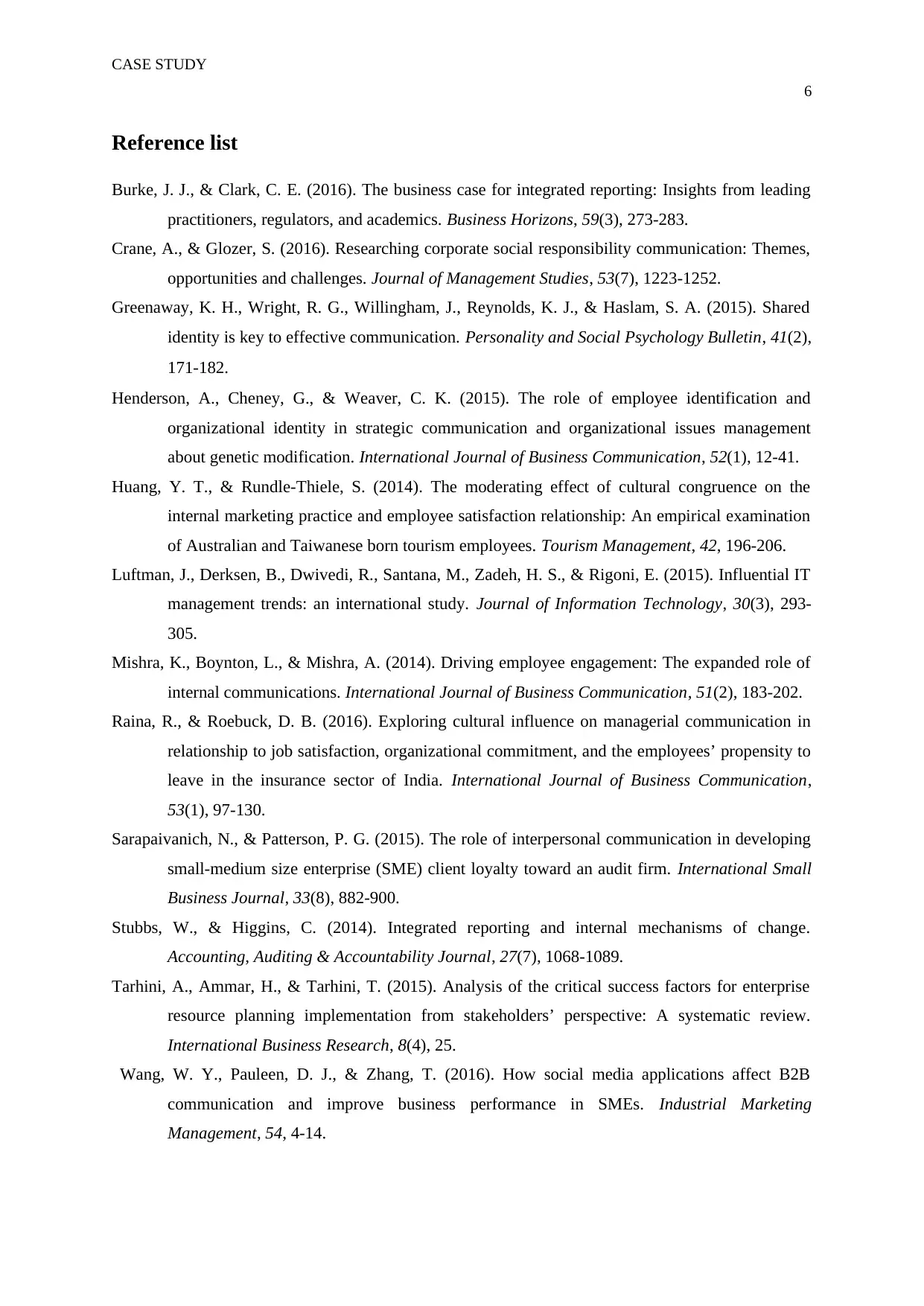
CASE STUDY
6
Reference list
Burke, J. J., & Clark, C. E. (2016). The business case for integrated reporting: Insights from leading
practitioners, regulators, and academics. Business Horizons, 59(3), 273-283.
Crane, A., & Glozer, S. (2016). Researching corporate social responsibility communication: Themes,
opportunities and challenges. Journal of Management Studies, 53(7), 1223-1252.
Greenaway, K. H., Wright, R. G., Willingham, J., Reynolds, K. J., & Haslam, S. A. (2015). Shared
identity is key to effective communication. Personality and Social Psychology Bulletin, 41(2),
171-182.
Henderson, A., Cheney, G., & Weaver, C. K. (2015). The role of employee identification and
organizational identity in strategic communication and organizational issues management
about genetic modification. International Journal of Business Communication, 52(1), 12-41.
Huang, Y. T., & Rundle-Thiele, S. (2014). The moderating effect of cultural congruence on the
internal marketing practice and employee satisfaction relationship: An empirical examination
of Australian and Taiwanese born tourism employees. Tourism Management, 42, 196-206.
Luftman, J., Derksen, B., Dwivedi, R., Santana, M., Zadeh, H. S., & Rigoni, E. (2015). Influential IT
management trends: an international study. Journal of Information Technology, 30(3), 293-
305.
Mishra, K., Boynton, L., & Mishra, A. (2014). Driving employee engagement: The expanded role of
internal communications. International Journal of Business Communication, 51(2), 183-202.
Raina, R., & Roebuck, D. B. (2016). Exploring cultural influence on managerial communication in
relationship to job satisfaction, organizational commitment, and the employees’ propensity to
leave in the insurance sector of India. International Journal of Business Communication,
53(1), 97-130.
Sarapaivanich, N., & Patterson, P. G. (2015). The role of interpersonal communication in developing
small-medium size enterprise (SME) client loyalty toward an audit firm. International Small
Business Journal, 33(8), 882-900.
Stubbs, W., & Higgins, C. (2014). Integrated reporting and internal mechanisms of change.
Accounting, Auditing & Accountability Journal, 27(7), 1068-1089.
Tarhini, A., Ammar, H., & Tarhini, T. (2015). Analysis of the critical success factors for enterprise
resource planning implementation from stakeholders’ perspective: A systematic review.
International Business Research, 8(4), 25.
Wang, W. Y., Pauleen, D. J., & Zhang, T. (2016). How social media applications affect B2B
communication and improve business performance in SMEs. Industrial Marketing
Management, 54, 4-14.
6
Reference list
Burke, J. J., & Clark, C. E. (2016). The business case for integrated reporting: Insights from leading
practitioners, regulators, and academics. Business Horizons, 59(3), 273-283.
Crane, A., & Glozer, S. (2016). Researching corporate social responsibility communication: Themes,
opportunities and challenges. Journal of Management Studies, 53(7), 1223-1252.
Greenaway, K. H., Wright, R. G., Willingham, J., Reynolds, K. J., & Haslam, S. A. (2015). Shared
identity is key to effective communication. Personality and Social Psychology Bulletin, 41(2),
171-182.
Henderson, A., Cheney, G., & Weaver, C. K. (2015). The role of employee identification and
organizational identity in strategic communication and organizational issues management
about genetic modification. International Journal of Business Communication, 52(1), 12-41.
Huang, Y. T., & Rundle-Thiele, S. (2014). The moderating effect of cultural congruence on the
internal marketing practice and employee satisfaction relationship: An empirical examination
of Australian and Taiwanese born tourism employees. Tourism Management, 42, 196-206.
Luftman, J., Derksen, B., Dwivedi, R., Santana, M., Zadeh, H. S., & Rigoni, E. (2015). Influential IT
management trends: an international study. Journal of Information Technology, 30(3), 293-
305.
Mishra, K., Boynton, L., & Mishra, A. (2014). Driving employee engagement: The expanded role of
internal communications. International Journal of Business Communication, 51(2), 183-202.
Raina, R., & Roebuck, D. B. (2016). Exploring cultural influence on managerial communication in
relationship to job satisfaction, organizational commitment, and the employees’ propensity to
leave in the insurance sector of India. International Journal of Business Communication,
53(1), 97-130.
Sarapaivanich, N., & Patterson, P. G. (2015). The role of interpersonal communication in developing
small-medium size enterprise (SME) client loyalty toward an audit firm. International Small
Business Journal, 33(8), 882-900.
Stubbs, W., & Higgins, C. (2014). Integrated reporting and internal mechanisms of change.
Accounting, Auditing & Accountability Journal, 27(7), 1068-1089.
Tarhini, A., Ammar, H., & Tarhini, T. (2015). Analysis of the critical success factors for enterprise
resource planning implementation from stakeholders’ perspective: A systematic review.
International Business Research, 8(4), 25.
Wang, W. Y., Pauleen, D. J., & Zhang, T. (2016). How social media applications affect B2B
communication and improve business performance in SMEs. Industrial Marketing
Management, 54, 4-14.
⊘ This is a preview!⊘
Do you want full access?
Subscribe today to unlock all pages.

Trusted by 1+ million students worldwide
1 out of 6
Related Documents
Your All-in-One AI-Powered Toolkit for Academic Success.
+13062052269
info@desklib.com
Available 24*7 on WhatsApp / Email
![[object Object]](/_next/static/media/star-bottom.7253800d.svg)
Unlock your academic potential
Copyright © 2020–2025 A2Z Services. All Rights Reserved. Developed and managed by ZUCOL.


